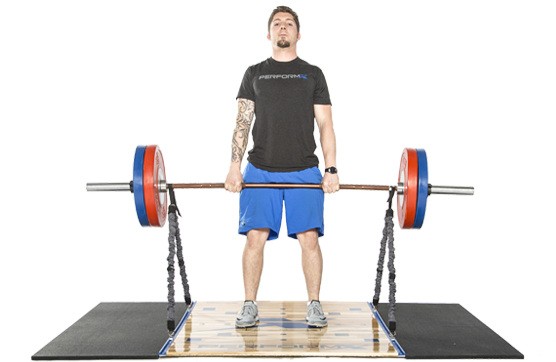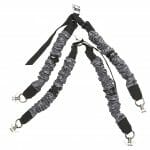An Innovative Approach to Cord-loaded Deadlifting

An Innovative Approach to Cord-loaded Deadlifting
Besides traditional training methods using the barbell, many coaches and athletes are adding resistance with bands– known as variable resistance training. This method of training aligns with the Dynamic Effort method outlined by Russian sport scientist Vladimir Zatsiorsky in Science and Practice of Strength Training and also popularized by Louie Simmons’ Westside Barbell method of training.
Dynamic Effort training is typically used with compound barbell lifts such as the Squat, Bench Press and Deadlift and thus is widely used by powerlifting athletes. However, many professional, collegiate and even high school athletes and strength coaches have adapted the use of bands or cord-loaded resistance training in their programs.
 In many facilities, band-resisted or cord-loaded deadlifts typically require awkward (and sometimes unsafe) set ups including standing on a circular band that is draped over the bar, wrapping circular bands around dumbbells, or attaching the bands to various hardware that has been bolted to a platform or the floor.
In many facilities, band-resisted or cord-loaded deadlifts typically require awkward (and sometimes unsafe) set ups including standing on a circular band that is draped over the bar, wrapping circular bands around dumbbells, or attaching the bands to various hardware that has been bolted to a platform or the floor.
Now, coaches and athletes can easily and safely accomplish cord-loaded deadlifts using the Perform-X Dead-X Cords which are easily attached into the Trak-X System on the lifting platform and onto the barbell using the unique cam-and-buckle system.

Several NFL, collegiate, and high school facilities have installed this unique system into their flooring and/or platforms. This includes installation during new construction or retrofitting into existing inlaid platforms and above ground platforms. In addition, this also allows for the Jump-X™ System to be used for cord-loaded vertical jump training.

 The cords come in four resistances with each being quantified based on the height of the bar. At a typical finishing position 36 inches off the ground, the average tension on the cord ranges from 70-190 lbs depending on the thickness (color) of the cord. This allows strength coaches to specifically program the weight on the bar as a percentage of the repetition maximum and the (variable) load from the cord.
The cords come in four resistances with each being quantified based on the height of the bar. At a typical finishing position 36 inches off the ground, the average tension on the cord ranges from 70-190 lbs depending on the thickness (color) of the cord. This allows strength coaches to specifically program the weight on the bar as a percentage of the repetition maximum and the (variable) load from the cord.
Is it effective? A recent review of the research by Suchomel et al. (Sports Medicine, 2018; see related blog below) suggests that this method of training produces superior gains in muscle adaptations compared to traditional training methods.
Related blogs
FOCUS ON RESEARCH: Q&A with Dr. Andy Galpin – Effects of Elastic Bands on the Deadlift
You can’t fire a cannon from a canoe: training the lower body
Training Considerations for Improving Muscular Strength: Q&A with Dr. Tim Suchomel